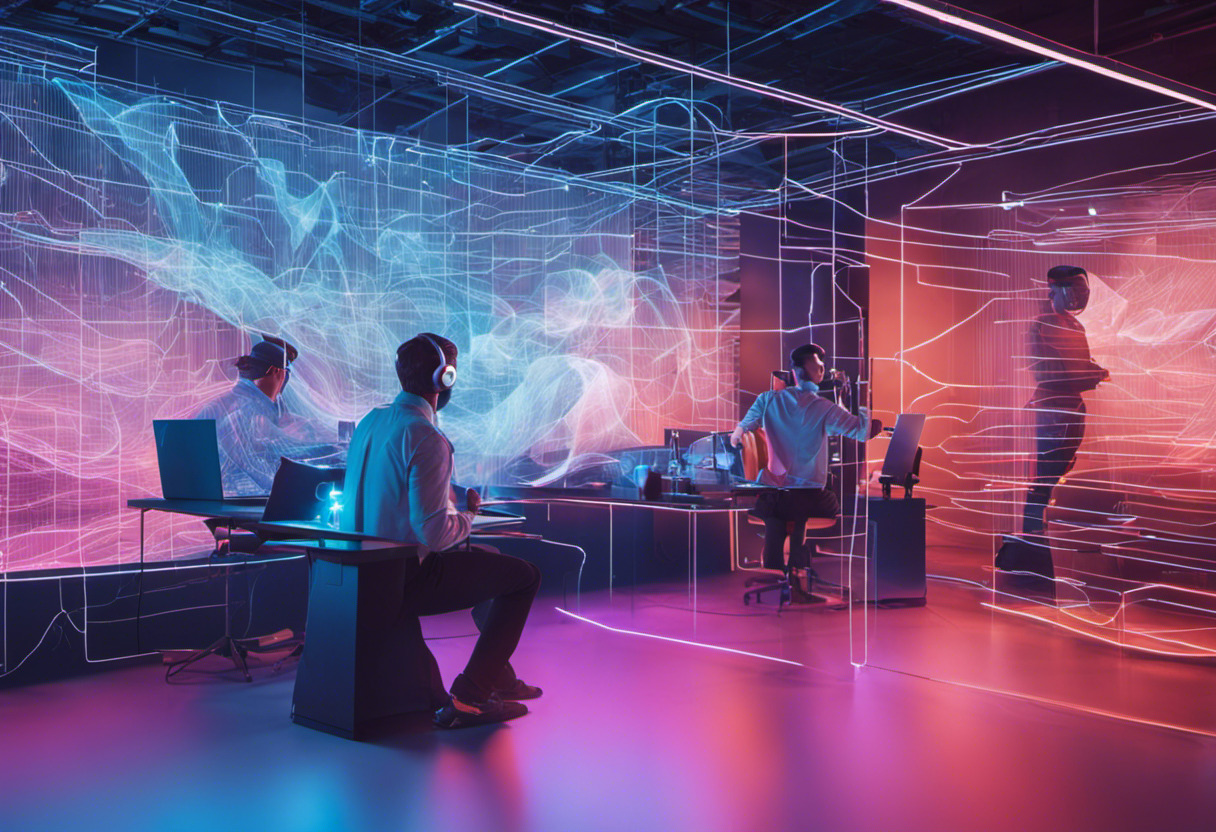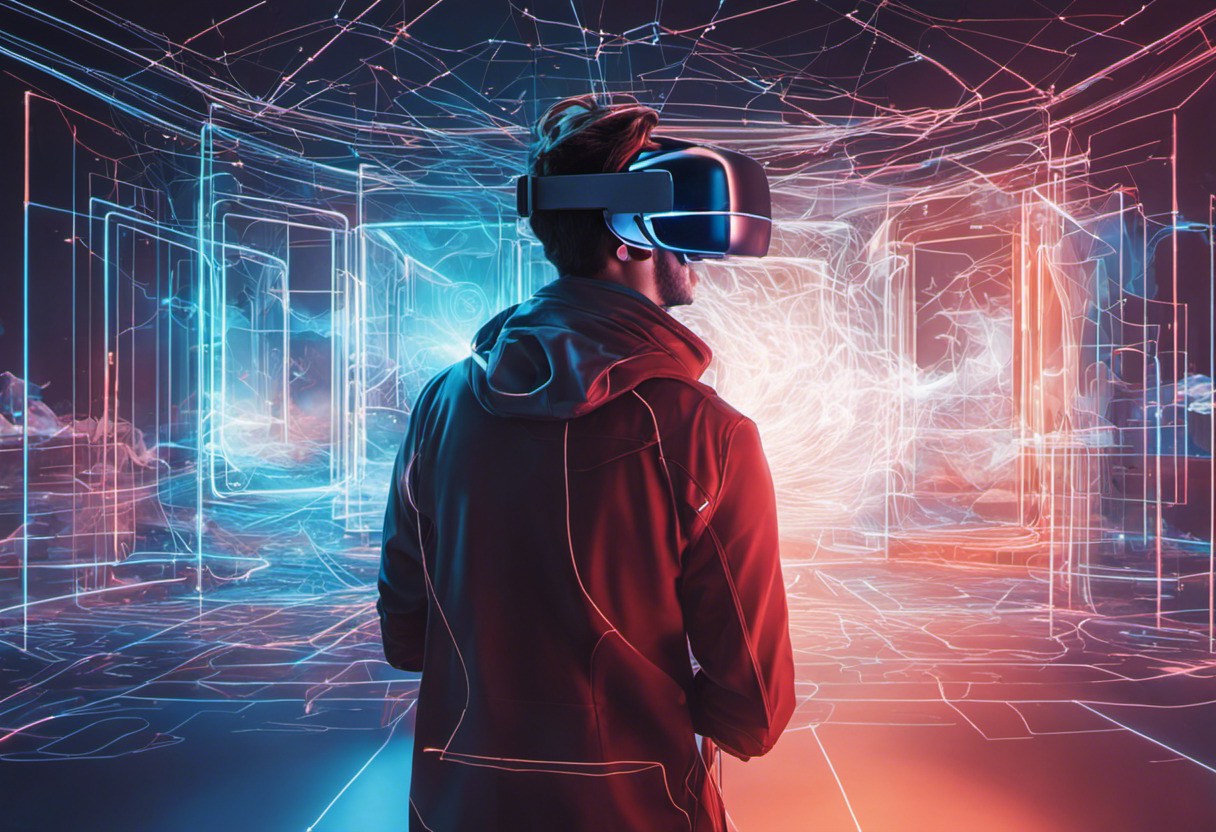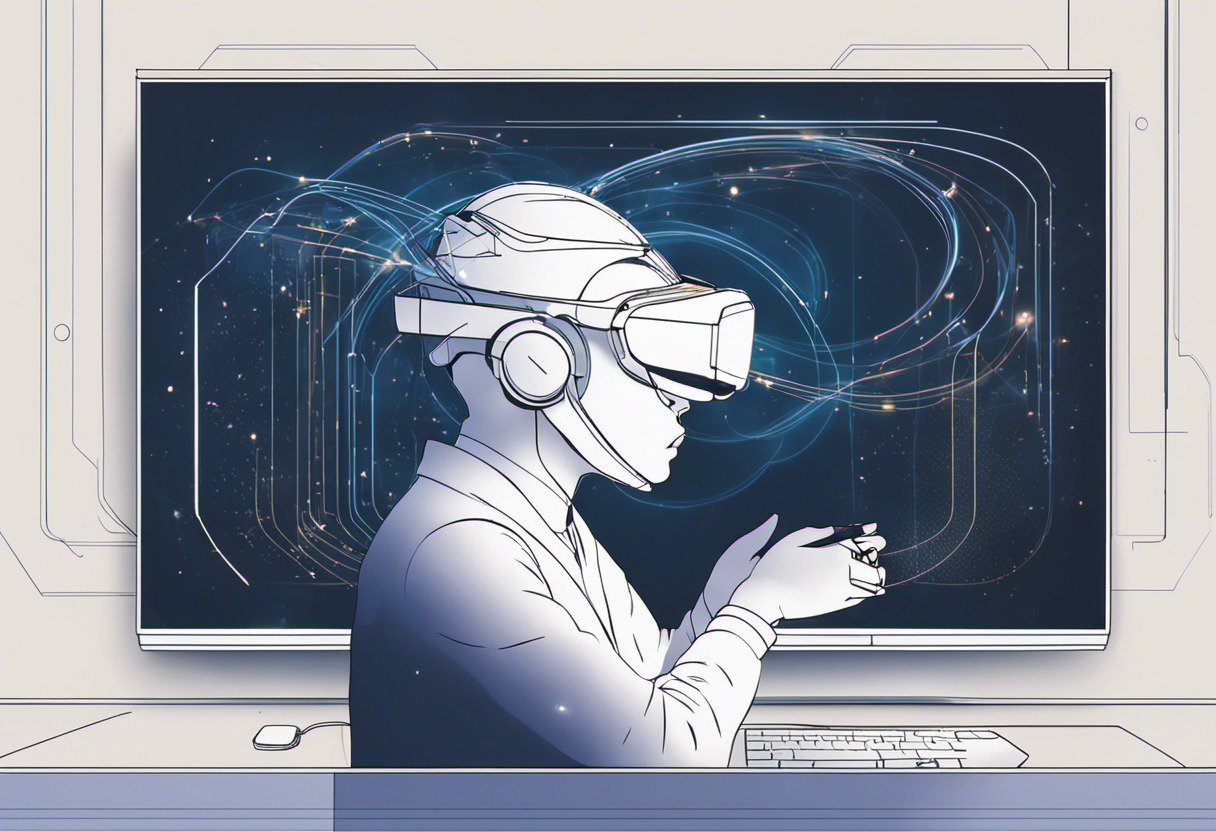- Unveiling the Real Issues with Security in Web AR
- An Inside Look at the Reality of AR Content
- Risk of User Deception: AR’s Potential for Social Engineering
- Safety of Wearable AR Devices: The Crucial Blank Spot
- Delving into the Privacy Implications in Virtual Reality
- Maintaining AR/VR User Safety: Measures to Uphold Security
Security and privacy concerns in Web AR incorporate issues like higher risks of data vulnerability due to extensive user information collection, potential hacking attacks, and unreliable content generated by third-party vendors. These vulnerabilities also present potential avenues for denial of service attacks, cyber threats including spoofing and data manipulation, and even the risk of social engineering.

This article will provide an in-depth understanding of the inherent security and privacy issues associated with Web AR and offer measures to mitigate these risks.
Unveiling the Real Issues with Security in Web AR
As we continue to traverse this hi-tech era, augmented reality (AR) technologies are proving to be enigmatic players, merging digital information with our physical surroundings with the use of browsers. Web AR, like all technological advancements, is not without its security concerns. Let’s delve into some of which are rapidly gaining attention in the IT community.

The Deepening Privacy Dilemma
AR applications demand access to an extensive array of user information, placing heightened privacy issues in the limelight. This collected data isn’t just limited to, but supersedes, that procURED through social networks. To give an idea:
- Physical Location: User geolocation is paramount for AR applications to function optimally, constructing contextually enhanced reality.
- Visual Data: AR apps often call for camera access, potentially intruding on personal or even sensitive spaces.
- User Interactions: User behavior analysis for customized experiences escalates an underlying predicament of privacy invasion.

So while AR seeks to create user-centric experiences, the amount, and the depth of data collected raises serious privacy concerns.
Potential Vulnerability to Hacking: Data Usage, Security, and Storage
Following closely on the heels of privacy issues is the looming threat of hacking. AR, as a technology leverages intricate data usage, creating a complex network that hackers might exploit. For more on this, you can check out this post on understanding the intricacies of Web AR.
The fundamental questions extend to data usage, its subsequent storage, and most significantly, its security, which become hotbeds for potential cyber-attacks. As a matter of fact:
- Data Storage: Large data repositories, both on device and cloud storage, become attractive targets for cybercriminals.
- Data Transmission: The extensive data exchange between AR platforms and users’ devices presents potential points of hacking, thereby compromising data integrity.

The Threat of Denial of Service Attacks in Critical Situations
Denial of Service (DoS) attacks, targeting the availability of services could lead to serious implications, more so in professions where AR assists in critical operations. Sudden failure of AR apps could, for instance, interrupt surgical procedures guided by AR, leading to life-threatening circumstances. Such vulnerabilities inevitably raise important questions about the robustness of AR technology.
Thus, the intersection of AR and security is a complex one filled with fundamental questions and concerns that need addressing. We have crossed the realm where digital security was a side concern, it’s now a prime issue, and rightly at the centerstage where AR developments are concerned.
An Inside Look at the Reality of AR Content
In the world of Web AR, we face a unique and unnerving predicament: the rampant proliferation of unreliable content created and delivered by third parties. Alongside its unmatched potential, Web AR walks a thin line between innovation and privacy invasion, and the balance is far from perfect.
Third-Party Vendors: A Double-Edged Sword
The authenticity of content in Web AR is a significant concern due to its delivery mechanism. Typically, AR content is generated and distributed by myriad third-party vendors, each harbouring potentially differing security and privacy standards. This disparity could undermine the credibility of augmented reality experiences, depriving them of the trust they deserve.
Emerging response to this issue is the development of authenticated content generation and transmission mechanisms. They aim to bolster the trustability of AR content by ensuring its legitimacy and origin.
Risks Undermining Certified Content Sources
Like any other web-based system, Web AR services can become victims of malicious cyber operations, including but not limited to spoofing, sniffing, and data manipulation. Each of these techniques allows malevolent actors to tamper with the authenticity of certified content sources, thereby jeopardizing their reliability.
- Spoofing: Masquerading as an authentic source to disseminate false information.
- Sniffing: Intercepting data during transmission to gain unauthorized access to sensitive information.
- Data manipulation: Modifying data at rest or transit to serve ill-intentioned purposes.
Such illegitimate activities pose a critical threat to the integrity of Web AR content and serve as a vital marker for initiating stronger cybersecurity protocols.
Is There a Solution?
Challenges abound, but hope is not lost. There is an extensive range of solutions being proposed to curb these threats, from robust and transparent authentication protocols to intricate mechanisms that can predict and prevent suspicious activities. To delve into their detailed implications and how they contrast against each other, visit this comprehensive explanation of Web AR, VR, and XR paradigms, where you will unlock an array of knowledge about the incredible world of augmented and virtual realities.
| Cyber Threat | Definition | Impact on Web AR |
|---|---|---|
| Spoofing | Impersonating legitimate content sources to distribute malicious content | Undermines the trust in Web AR content, making users skeptical about its credibility |
| Sniffing | Intercepting data during its transmission | Threatens user privacy and the integrity of AR content |
| Data Manipulation | Altering AR data at rest or in transit | Degrades the authenticity and reliability of AR services |
Risk of User Deception: AR’s Potential for Social Engineering
Augmented reality (AR), being at the intersection of digital and physical realities, presents a plethora of security risks. The section explores some of these challenges, primarily focusing on the susceptibility of AR to social engineering attacks and deception.
Potential Unreliability of AR Content
A core concern emanates from the potential unreliability of AR content, often stemming from the vast scope for manipulative interactions. Hackers adept at social engineering techniques can craft misleading AR displays, creating digital signs or altering the reality of an AR environment.
This reality manipulation stratagem can be devastating in a real-world context. Imagine being guided off course because your AR maps app displayed the wrong signs. The adverse effects could range from mere inconvenience to life-threatening scenarios.
The gravity of this threat can be better understood with an example. Let’s consider two AR apps – one legit and the other manipulated by a hacker.
| Legit AR App | Hacker-manipulated AR App |
|---|---|
| Displays accurate digital signage | Fakes signs leading to unanticipated locations |
| Respect user privacy and secure data | May breach user privacy and misuse data |
The above instances are representative of many such potential manipulation scenarios, making AR a fertile ground for social engineering attacks.
Prevalence of Malware in AR Applications

Another legitimate fear in the realm of AR is the insidious embedding of malware into applications. The advent and growth of AR have blurred the lines of traditional advertising. Interactive advertising, engaging product visualizations, and other innovative in-app displays have become a norm in AR marketing.
However, these intrusive formats have become a breeding ground for malware infusion. Unsuspecting users might end up clicking on fake ads, lured into installing malicious software, and unknowingly compromising their devices.
Threat of Man-in-the-Middle Attacks
AR applications inherently require constant communication between multiple entities – the AR browser on user’s device, various servers hosting AR content, and more. At any moment, this communication can fall prey to ‘Man-in-the-Middle’ (MITM) attacks, a prevalent form of security threat, leading to data theft and harmful alteration.
In such attacks, malicious actors insert themselves into conversations between two parties, easily gaining access to sensitive data being transferred.
A breach of this nature can have varying degrees of impact, from the manipulation of AR content to full-blown data theft, leading to enormous privacy infringements.
To gain an in-depth understanding of these and more advantages of Web AR over traditional apps, this comprehensive guide with expert insights makes for an essential read.
Ways to Counteract AR Security Threats
While AR does indeed present significant security risks, multiple strategies can help mitigate them:
- Users must stay informed about the latest threats in AR and take proactive measures to protect their devices and data.
- Vigilant observation of AR content, resisting the urge to click on every shiny new feature or advertisement, can help avoid malware traps.
- Employing trusted and robust security solutions, such as firewalls and antimalware suites, can fortify user devices against MITM attacks.
- Always keeping AR apps up-to-date, as developers often resolve security issues in updates.
Though quite enticing from a usability perspective, AR is not without its pitfalls. Balancing the benefits against potential threats could be the key to a secure AR experience.

Safety of Wearable AR Devices: The Crucial Blank Spot
In our exploration of Web AR security concerns, the protection surrounding wearable augmented reality (AR) devices emerges as a critical area of inquiry. Given their accessibility and involvement in meticulous data collection, these gadgets can be a potential target for nefarious activities.
Physical Security: A Significant Concern in the AR Landscape
The wearable AR devices, with their portable disposition, potentially face the risk of physical harm or theft. This concern is magnified by these gadgets’ value, which blends cutting-edge technology and comprehensive personal data of the user.

Potential damage to these devices, whether through accidents, vandalism or theft, can disrupt the user experience and pose a severe threat to personal privacy. The datasets stored within these devices might include intimate details about the user’s lifestyle, activities, and preferences, revealing a lot about their identity.
Ransomware Attacks: A Potential Threat to User Privacy
Another significant threat to the safety of wearable AR devices is the risk of ransomware attacks. Sophisticated cybercriminals may infiltrate the AR device to record the user’s behavior and interactions within the augmented reality.

These unauthorized recordings could be used as a bargaining chip, where hackers threaten to publicize the user’s private experiences unless a hefty ransom is paid. This scenario paints an unsettling picture about the vulnerability of such immersive technologies and its implications on individual privacy.
Steps for Mitigating Risks
- Secure the device by keeping it in a safe place when not in use.
- Regularly update software and firmware to prevent potential security vulnerabilities.
- Install recommended security software specifically designed for wearable devices.
- Be cautious while interacting with unknown applications or content within AR.
For an additional layer of understanding, I encourage you to explore this featured resource: “Analyzing Various Browsers’ Support for Web AR”, which also addresses the safety protocols followed by different browsers when it comes to augmented reality applications.
Seeking Balance Between Augmented Reality and Security
As exciting as augmented reality can be, it is crucial to ensure it does not compromise user safety and privacy. By gathering awareness and employing best practices, users can enjoy the benefits of AR technology while maintaining their security. After all, a well-informed user is the best defense against security threats.
Delving into the Privacy Implications in Virtual Reality
In the multifaceted realm of Virtual Reality (VR), privacy concerns are mirrored and heightened. An area of particular unease is the nature of the collected biometric data, which carries a distinctly personal and invasive quality.
Understanding the Intimate Nature of Biometric Data in VR
The data procured in VR far surpasses the breadth and depth of data gathered by mainstream platforms and apps. This data, inherently personal, evokes a significant privacy issue. Companies using VR collect users’ physical attributes, behavioural patterns, and even emotional states through interactive experiences. The accuracy and micro-level depth of this information opens up a veritable Pandora’s box of privacy concerns.

Anonymizing VR and AR Activities: A Future Challenge
Emphasizing the gravity of these privacy concerns is the difficulty in anonymizing VR and AR tracking data. Unique patterns of movement and behavioural cues led by individuals, termed as biometric identifiers, can be used to recognize and track them despite efforts at anonymization. This presents a significant concern for those advocating for privacy rights in immersive technology.
- Impossibility of complete anonymity: Unique behavioural patterns in interacting with VR and AR make individuals identifiable.
- Risk to privacy: These identifiers, if compromised, could provide insight into sensitive personal information.
Implications of VR Data on Users and Third Parties
The repercussions of the data captured by VR goes beyond the immediate boundary of the user’s digital life. In a startling exploration of the future, VR data could potentially impact health insurance premiums, decisively influence users’ mental health, and raise questions about the user’s right to mental privacy.
VR Data and Health Insurance Companies
VR data can provide astonishingly detailed insight into a user’s lifestyle and physical health, such as exercise habits, dietary patterns, and even early indicators of health conditions like Parkinson’s or Alzheimer’s. This invaluable cache of data can have significant implications for health insurance companies. The likelihood of data being used to calculate premiums or even eligibility is a serious concern as this technology proliferates.
| Concerns | Implications |
|---|---|
| Detailed health insights | Risk of disadvantaging users with adverse conditions |
| Exercise and diet patterns | Reversely, opportunity for companies to reward health-conscious lifestyles |
Repercussions on Users’ Mental Health and Right to Mental Privacy
On a more personal level, the opportunities for monitoring and analysing mental health are concerning. User interactions and reactions within VR experiences could provide in-depth insights into a person’s mental state, raising ethical questions about mental privacy. Furthermore, this data in the hands of ill-intentioned parties could manipulate users psychologically, exacerbating existing conditions, or even induce new mental health issues.

Understanding these challenges in VR and AR is vital. For deeper insights into how artificial intelligence is being used to personalize Web AR experiences, this resource is a comprehensive guide into how AI plays a significant role in shaping the user’s interaction with augmented and virtual realities.
Looking Ahead: Navigating Privacy in VR
As we advance into an age where VR becomes increasingly integrated into our everyday experiences, the preservation of privacy and anonymity becomes a significant, pressing challenge. The tech industry must empower users with the knowledge and tools needed to protect their privacy in this new landscape.
Maintaining AR/VR User Safety: Measures to Uphold Security
In a digital age where technology continuously enhances our daily lives, it’s essential to address methods to augment the security of users in augmented and virtual reality spaces. Understanding safety measures, and how to implement them effectively, can mitigate the majority of security concerns and protect user data. Here, we detail these protective pointers.
Manage Personal Information Disclosure
Augmented and virtual reality platforms, like many digital services, require some degree of personalized data to deliver user-tailored experiences. Yet, the correlation between more data and a higher degree of personalization induces potential risks for users.
VR and AR users render themselves vulnerable to data exploitation when they share unnecessary or overly personal information. Thus, disclosing the minimum information required to use the service efficiently is pre-eminent. It’s a rule of thumb to remain prudent about the information shared while interacting within AR and VR environments.

- Sharing the least necessary information: Limit your profile to only the necessary data elements. Be mindful of the personal information you share in the virtual world.
- Use pseudonyms: Instead of using your real name, consider employing a pseudonym to negate the chances of being identified or traced.
- Manage visible information: Oversee the data visible to other users and platforms. Make sure to keep your private data private by monitoring it continually.
Regular Review of AR/VR Platforms’ Privacy Policies
As users, becoming familiar with the privacy policies of the AR and VR platforms we use should be second nature. These regulations establish the kind of data collected, the means of its use, and storage conditions. Moreover, updates in privacy policies may confer new permissions inadvertently granted during an application update, envisaging potential misuse. Therefore, you should maintain the firmware of VR headsets and AR wearables up-to-date, and routinely revisit privacy policies.

Invest in Comprehensive Antivirus Software and VPN services
Notwithstanding the inherent security measures in AR/VR devices, employing a comprehensive antivirus program and a robust VPN service is a smart investment. Antivirus software can detect and dispose of malicious threats, helping to safeguard your devices and data. Simultaneously, VPN services can encrypt your internet connection, making your online activities virtually untraceable to potential adversary Hackers.
Choosing Antivirus Software and VPN: Key Considerations
While there are multiple market options, the selection of the most suitable Antivirus software and VPN services depends on multiple factors, which include:
| Aspect | Antivirus | VPN |
| Functionality | Should be able to detect and dispose of a wide range of threats. | Should have the capability to encrypt data and secure your internet connection. |
| Compatibility | Must be compatible with your device and the AR/VR applications you use. | A comprehensive VPN should be compatible with different operating systems and devices. |
| User-friendliness | Easy to install and use. | Intuitive interface and straightforward setup process. |
Through a combination of these safety measures, one can navigate AR/VR spaces with the assurance of heightened privacy and security. As we continue to advance in technology, these protocols will change and evolve to further protect users and their data, building trust in these emerging platforms.
Grant Sullivan
Content writer @ Aircada and self proclaimed board game strategist by day, AI developer by night.





